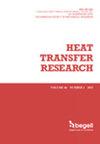A temperature pre-rectifier with continuous heat storage and release for waste heat recovery from periodic flue gas
IF 1.6
4区 工程技术
Q3 THERMODYNAMICS
引用次数: 0
Abstract
Flue gas from periodic furnaces with large temperature fluctuation is difficult to be recovered by regular heat exchangers. To recover that unstable waste heat, a Temperature Pre-Rectifier (TPR) with honeycombed structure is developed to smooth down the temperature fluctuation by continuous heat-storing and releasing. A three-dimensional model with unsteady flow and heat transfer is constructed to analyze the heat transfer process. Temperature rectification rate η is defined to quantify the smoothing-down effect of temperature fluctuation. The η exhibit the most efficient performance when relative scale (s/δ) is 1.0. The optimized honeycomb size sopt increases exponentially with the inlet temperature fluctuation intensity ξinlet. The η is increased with dimensionless length l*. TPR with segmented structure (s and δ decreased in each segment) can enhance the η with relatively shorter length. Three-segmented structure with a proportion of 0.18:0.33:0.49 can achieve η higher than 0.947, which is recommended for application. Industrial experiments verified that the temperature fluctuation is rectified from 568~1709 K to 1089~1174 K (η = 0.926). A new perspective on waste heat recovery of periodic flue gas based on TPR is provided, and enhancing the efficiency of TPR may be a future challenge.带持续热量储存和释放功能的温度预整流器,用于定期回收烟气中的余热
周期性窑炉产生的烟气温度波动较大,一般的热交换器难以回收。为了回收这种不稳定的余热,我们开发了一种具有蜂窝状结构的温度预整流装置(TPR),通过持续的蓄热和放热来平缓温度波动。为分析传热过程,建立了一个具有非稳态流动和传热的三维模型。定义了温度整流率 η,以量化温度波动的平滑效应。当相对比例(s/δ)为 1.0 时,η 表现出最有效的性能。优化后的蜂窝尺寸 sopt 随入口温度波动强度 ξinlet 呈指数增长。η随无量纲长度 l* 的增加而增加。具有分段结构的 TPR(每段的 s 和 δ 均减小)可以在相对较短的长度内提高 η。比例为 0.18:0.33:0.49 的三段式结构可使 η 高于 0.947,值得推荐应用。工业实验证明,温度波动可从 568~1709 K 矫正到 1089~1174 K(η = 0.926)。这为基于 TPR 的周期性烟气余热回收提供了一个新的视角,提高 TPR 的效率可能是未来的一个挑战。
本文章由计算机程序翻译,如有差异,请以英文原文为准。
求助全文
约1分钟内获得全文
求助全文
来源期刊

Heat Transfer Research
工程技术-热力学
CiteScore
3.10
自引率
23.50%
发文量
102
审稿时长
13.2 months
期刊介绍:
Heat Transfer Research (ISSN1064-2285) presents archived theoretical, applied, and experimental papers selected globally. Selected papers from technical conference proceedings and academic laboratory reports are also published. Papers are selected and reviewed by a group of expert associate editors, guided by a distinguished advisory board, and represent the best of current work in the field. Heat Transfer Research is published under an exclusive license to Begell House, Inc., in full compliance with the International Copyright Convention. Subjects covered in Heat Transfer Research encompass the entire field of heat transfer and relevant areas of fluid dynamics, including conduction, convection and radiation, phase change phenomena including boiling and solidification, heat exchanger design and testing, heat transfer in nuclear reactors, mass transfer, geothermal heat recovery, multi-scale heat transfer, heat and mass transfer in alternative energy systems, and thermophysical properties of materials.
 求助内容:
求助内容: 应助结果提醒方式:
应助结果提醒方式:


